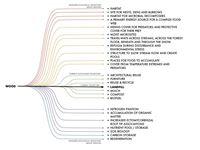Language of Architectural Wood: Waste to Ecological Abundance

This paper investigates the terms and narratives that have come to shape the language of wood used by the architectural profession (architectural wood) and forest scientists (ecological wood) and proposes a synthesis based on the concept that ecological benefits depend on an abundance of materials. This research in architectural wood looks to contemporary construction methods as well as the historical evolution from the forest to human product.
This investigation shows how architectural thinking favors the structural language of “strength” and “efficiency,” as well as the avoidance of key ecological functions prevalent through terms such as “pests” and “decay.” Materials are favored for their linear and human functions, and once exhausted, are discarded and removed from the architectural process. Ecological wood is defined by forest science research in coarse woody debris. The research in ecological wood revealed concepts of redundancy and terms associated with decomposition, disturbance, and legacies. These processes are favored by a multitude of species for their complex latent properties and serve various ecological roles simultaneously.
The fundamental differences in language reveal deep barriers that may discourage ecological collaborations. The conclusion proposes to elevate the concept of ecological abundance by responding to architectural design gaps revealed through ecological research. The response aims to construct and prepare a more collaborative design language between designers and scientists.
keywords: Ecology, Wood, Sustainability, Disturbance, Language


Add comment
Log in to post comments